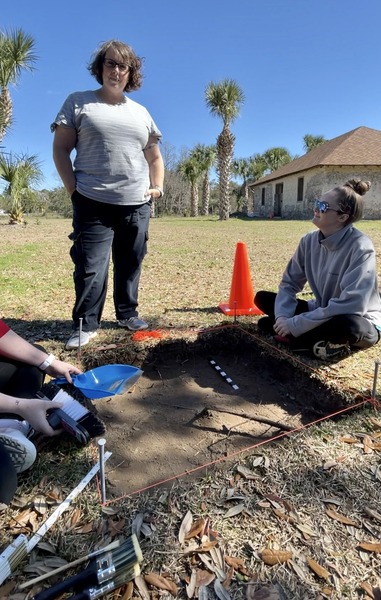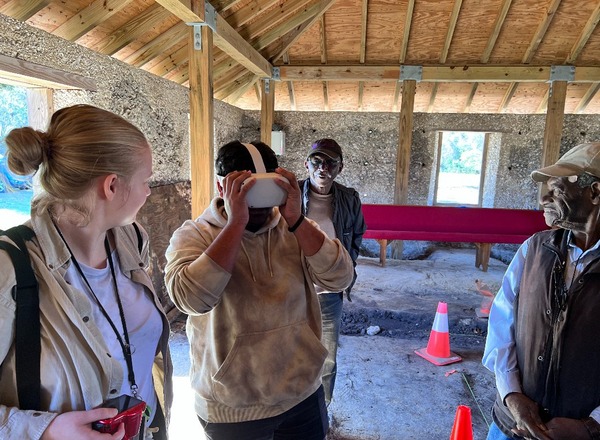USCB's Archaeology Project Advances at Barnwell Tabby Site on HHI
 Dr. Cavanagh leading students Parker Vaughan and Erin Andrews at the Barnwell Tabby
dig after the Savannah River Archaeological researchers came to view the site.
Dr. Cavanagh leading students Parker Vaughan and Erin Andrews at the Barnwell Tabby
dig after the Savannah River Archaeological researchers came to view the site. Excavating an archaeological site is always an exciting adventure, but when the project is part of a university course and unearths previously unknown aspects of an area’s history, it is even more thrilling. This has been the case for Dr. Kim Cavanagh's Principles of Archaeology class (ANTH-B319) at the University of South Carolina Beaufort, who partnered with Mr. Thomas Barnwell for the Barnwell Tabby Excavation Project on Hilton Head Island. Dr. Cavanagh is an Associate Professor of Anthropology at the University of South Carolina Beaufort. The other members of the Barnwell Tabby Excavation Project are Dr. Audrey Dawson (USCB anthropology adjunct) and Dr. Eric Plaag (Carolina Historical Consulting).
The focus of this ongoing archaeological project is on a tabby structure (38BU90) located on Hilton Head Island, and their goal was to answer three key questions: when was it built, how was it used, and how were enslaved people involved? The project began in the spring and summer of 2019 and continued every weekend, with students finding numerous clues to human activity on the site over centuries, including pieces of charcoal, animal bones, glass, and pottery fragments.Thanks to the diligent work of these students and the research team, a narrative of the building is beginning to unfold through the lens of archaeology, archival research, and geological testing. The tabby building was constructed during the second half of the 18th century and it sits on the property went by the of Mahrabuoy during the pre-Revolutionary War period. It was likely burned in 1779 or 1781 during the British and Tory raids of the Skull Creek plantations.
The archaeology at the site has now extended beyond the building itself. “Last November a team of archaeologists from the Savannah River Archaeological Research Program (SRARP) came down from Allendale to help us out here at the Barnwell Tabby site,” says Dr. Cavanagh, “they did Ground-Penetrating Radar all around the building to see what sort of images might be appearing under the ground. GPR looks underground in a non-evasive way to see what things may have been happening underground. They found one spot that measures about 3 meters by 1 meter that showed some interesting anomalies in their footage. So, we are here today exploring the site to see what that might be.”
Student Erin Andrews, class of 2025 biology major and minoring in anthropology, is excited to explore the new dig site. “So right now, we’re about 15 centimeters down and the anomaly is sitting about 50 centimeters down,” says Erin, “we are preparing the area to start digging by getting everything all level and ready to excavate the area.”
The Barnwell Excavation Project has also highlighted the importance of anthropology as a discipline in the 21st century. Through their work, students were able to improve their communication skills, increase their cross-cultural understanding, develop their skills in social research, and analyze the root causes of social problems. For Dr. Cavanagh, anthropology provides insight and training that are particularly well-suited to the challenges of our globalized world but also carries significant impacts for local communities.
As she continues to explore the archaeology of the Barnwell site, she hopes to use digital ethnographic methodologies to reframe the early history of Hilton Head Island. She is partnering with Jim Sideletsky, (Assistant Professor of Art at USCB) and Dr. Brian Canada (Associate Professor of Computational Science), along with their students to develop a virtual reality (VR) experience to help tell the story of the Barnwell Tabby
 USCB Computer Science student, Nithish Dirisipamu, trying out a VR headset at the
Barnwell Tabby site.
USCB Computer Science student, Nithish Dirisipamu, trying out a VR headset at the
Barnwell Tabby site.